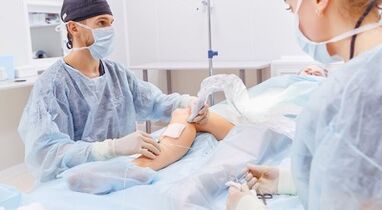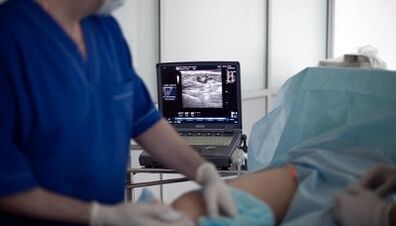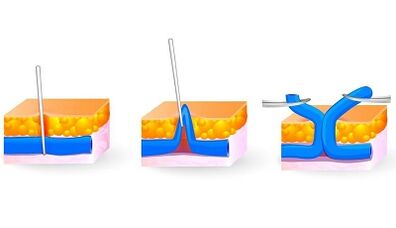
For many decades, the surgical treatment of varicose veins of the legs remains the only radical method to eliminate this disease and its complications.
Thanks to modern technologies and the improvement of operational techniques, it is truly effective both in therapeutic and cosmetic terms, it is carried out as easily and painless as possible, well tolerated by patients and does not cause prolonged disability.
Indications and contraindications
It is not advisable to manage patients with varicose veins.There are clear indications for the operation and contraindications to its implementation.
The surgical treatment of varicose veins of the lower ends is indicated in the following cases.
Medical indications- a pronounced expansion of 2-3 degrees, accompanied by complaints and signs of chronic venous insufficiency:
- convincing veins and stretched under the skin;
- more boasts (nodes) along the modified ships;
- swelling of the affected leg;
- gravity and pain along the expanded vein;
- convulsions in the muscles of the calf of the lower part of the leg, when “it reduces the leg;
- Inflammatory changes in the veins - thrombophlebitis;
- School-signing troop skin disorders, redness, sealing the subcutaneous layer, a gross long-wound jazva.
Cosmetic indications- early phase (first) of varicose veins without signs of venous insufficiency, causing only a cosmetic defect and aesthetic discomfort in the patient:
- veins slightly expanded and twisted superficially;
- "Vascular stars," spider "and small reddish blue capillaries in the skin of the legs.
It is important to remember that even if there are indications from the operation, it must be refused if the risk exceeds the benefit.
The main contraindications for the surgical treatment of varicose veins:
- The serious general condition caused by any acute (heart attack, stroke, pneumonia) has launched chronic diseases (liver, friendly, pulmonary failure) or patient old age.
- Any acute infectious diseases.
- Conductive treatment for cancer.
- Pronounced anemia.
- An increase or a pronounced decrease in blood coagulation.
- Inflammatory and additional processes (scores, rashes) on the skin of the lower limb, in which the surgery is planned.
- Pregnancy and postpartum period.
All contraindications, with the exception of the first, are considered relative.This means that in special circumstances (acute dangerous conditions caused by varicose veins, for example thrombophlebitis on the thigh), it is necessary to perform a volume or another volume of surgical treatment.
When an emergency operation is needed
In one case, an emergency surgical treatment of varicose veins of the legs can be requested, with acute ascending thrombophlebitis.This complication is an inflammation within the light of a large subcutaneous vein, accompanied by the formation of blood clots.

If such a pathological process applies to the thigh, there is the risk of tightening blood clots in a deep venous system.In case of separation of this blood clot, it penetrates the lung pots and oscillates them, which causes a threatening life of a dangerous disease - pulmonary thromboembolia (pulmonary fiber).
The main demonstrations of thrombophlebitis on the increase in the thigh:
- pain along the vein along the internal surface of the thigh;
- redness and increase in the temperature of the skin;
- The seal of the changed area and its strong pain in palpation.
With ascending thrombophlebitis, the volume of surgical treatment can be represented:
- CrosSctomy - Condiment and the intersection of a large subcutaneous vein to the place of confluence with the bed of Bednaya;
- Removal of a vein changed after a preliminary dressing.
The objectives of the surgical intervention
Normally, about 30% of the blood from the lower ends flows through small subcutaneous venous tributaries, which merge into two central venous trunks: a large and small subcutaneous vein.These vases are directly connected to the deep veins, through which 70% of the blood flows.In the places of these compounds there are valves that cross the blood only from the deep surface veins.
There are also dozens of small veins, which are called perforating, which also connect the venous surface network with deep.They also have valves that cross the blood in one direction.
The main cause of the varicose veins is the failure of the venous valves, which leads to improper blood discharges: from deep veins to the surface, which increases the pressure in them and leads to the expansion of small vessels and central venous trunks.
The main objectives for which surgical treatment is aimed at the varicose veins of the lower ends:
- The elimination of the stagnation of the blood in the altered surface veins of the legs, which will prevent the progression of chronic venous insufficiency and trophic disorders on the skin.
- Removal of deformed vases and varieties that represent a cosmetic defect.
- The elimination of the drainage of the blood from the deep veins in the superficial ones: the binding and the intersection of the perforating veins (clan), as well as a large and small subcutaneous veins in the places of their connection with the deep ones.
- Prevention of a repeated occurrence of varicose veins.
Preparation for the operation
The complete preparation for surgical treatment for varicose veins includes:
- A general preoperative examination that allows you to evaluate the general blood and health tests of the patient, coagulogram, biochemical analysis, blood type and RH factor, syphilis test, blood sugar level, pulmonary radiography, ECG.
- Special diagnostics that allows you to determine the characteristics of the disease: an ultrasound with surface doppler mapping, deep veins and lower ends arteries and designating the position of the insolvent piercing veins.
- The operation is performed on an empty stomach, so in the morning of the day of the operation you cannot eat and drink.
- In the morning before the operation, it is necessary to carefully teach all the hair on the painful leg from the groin to the foot.
Treatment of female varicose veins

A separate place in the surgical treatment of female varicose veins of the lower limbs belongs to cosmetic surgery.After these interventions, not only pathologically altered veins, but also postoperative scars on the skin of the legs, or they are inconspicuous.
To obtain the maximum cosmetic effect, surgical surgery for varicose veins is carried out according to the following methods:
- Laser ablation or radio frequency veins-Curg the central trunks of a large and small subcutaneous vein under the control of ultrasound through a drilling of the skin on the thigh or on the foot.
- Scleroblitteration and sclerotherapy-Felular subcutaneous and small subcutaneous veins, as well as all their tributaries, even the little ones, with a special sclerocante drug.
With any of the treatment methods described, the varicose veins are not removed, but are transformed by the blood vessels into a soft cicatricial tissue.Both physical influences (laser rays, radio frequency) and chemical compounds (sclerosing) destroy the internal layer of the vein.Thanks to this, it loses the light, glue and completely desolate from the blood, transforming itself into a normal connective tissue (cicatricial).
Therefore, without the direct removal of the veins, all the objectives assigned to the rapid treatment of the varicose veins of the lower ends are achieved: the modified vessels are eliminated and the dangerous consequences of venous insufficiency are eliminated in them.
The only restriction of cosmetic operations in the treatment of varicose veins in women is possible only the veins slightly or limited to 1-2 degrees.During pregnancy and in the first postpartum period, the surgical treatment is contraindicated with the exception of acute situations that require an emergency intervention, for example, with ascending thrombophlebitis.The operation is limited to the dressing of a large subcutaneous vein in the place of its connection with the femoral (Crocectomy).
Types of surgical operations
Consider the most common surgical interventions in the treatment of varicose veins of the lower ends: laser ablation, endoscopic dissection of the veins and phlebectomy.
The latter is divided into the following types:
- Classic operation or complete stripping or operation of Trojanov-Trendelenburg-Bubko-Narata;
- short stripping;
- Miniflectomy.
Flobectomy
Removal, the extraction of veins from under the skin is called phlebectomy.This is one of the first methods of surgical treatment of varicose veins of the lower ends.But even today, phlebectomy is often performed by phlegology and vascular surgeons.There are three changes and operating methods: short stripping, miniflectomy.
The volume of intervention is presented:
- Like a trunk bandage of a large subcutaneous vein in the place of its confluence, 2-3 cm on the thigh under the inguinal fold, in the thigh, through an incision.
- Its removal through the inguine to the foot using a special probe through two skin cuts 1-2 cm along the internal surface near the knee and ankle.
- The removal of all varicose veins and small veins through small separate engravings is about 1-2 cm (they can be from 5-6 to 10-20) with the dressing of insolvent perforative vessels.
- Sew all wounds with cosmetic seams.
Classical phlegmctomy allows you to remove varicose veins, but the most traumatic of all existing techniques.
Short stripping
With a short stripping, the entire large subcutaneous vein is not removed, but only its fragments, influenced by varicose veins, for example, only on the thigh or on the lower part of the leg.Healthy segments are not removed.This reduces the trauma of the intervention, but remains the risk of recurrence of the disease.Otherwise, the operational operations of the operation are similar to classical phlebectomy.
Miniflectomy

The innovative methodology for the removal of small varicose veins of a large subcutaneous vein is called miniflectomy.
For its implementation, special tools are needed (pointed scalpels, hooks, terminals, spatula), with which the veins are extracted through the skin of the skin several millimeters.It is not necessary to sew these leather defects, the scars are invisible.
Very often, surgeons combine a short or complete stripping of a large subcutaneous vein with miniflectomy.Such a combined operation combines radicalism and minimum trauma with a good cosmetic effect.
Endoscopic dissection of the veins
Finding all the lower veins lower during any phlebectomy is difficult.For these purposes, endoscopic equipment (video camera and manipulators) are used.Through small cuts in 1-2 cm, they are inserted under the skin in places of groups of perforating veins, which are detected with ultrasound.
Under the control of the camera, all lower perforators find, bandage and cross.During this operation, the subcutaneous veins are not removed.It can be performed both independently and in combination with any type of phlebectomy: stripping, miniflebectomy.
Laser treatment
The laser ablation for varicose veins involves combustion with a laser beam of a large subcutaneous vein throughout the side of its clearance.To do this, through the drilling of the skin on the thigh or in the ankle area in the lumen of the vein, a catheter-vesty is introduced throughout its length.Under the control of the ultrasound, Svetovod is slowly extracted.
The laser beam, which acts on the venous wall, destroys the internal layer.As a result, Vienna falls and ceases to work, which is clearly visible on the ultrasound monitor.If not only the main venous trunk, but also its tributaries, are removed from the varicose veins, are removed according to the miniflebectomy method.
Rehabilitation
Regardless of the operating methods for the treatment of varicose veins, the restoration of patients in the postoperative period occurs quickly.The complete rehabilitation terms depend on the methodology of surgery, the stage of the disease and the general conditions of the patient.With the laser treatment and the miniflebectomy of the initial varicose veins, it is 2-3 weeks, with classical phlegm for advanced forms of the disease-1-3 months.
It is recommended to walk as soon as possible, provided that the condition is stabilized after anesthesia, after 5-6 hours.If spinal anesthesia has been performed, bed rest is recommended within 12 hours.With local anesthesia, the patient can leave the operating room standing and is not even hospitalized.The main condition before walking is that of bandage of the legs with an elastic bandage or putting a compression knitwear selected individually.
It remains in the hospital from 1-2 to 5-8 days.If the seams were overlapping, it is better to remove them in 7-8 days during a control inspection from a specialist.Within a month after surgery, it is recommended to wear a compression knitwear.It is necessary to put it every day before getting out of bed.At night, compression products are removed.After classical phlebectomy with serious varicose veins, it is better to continue compression for a maximum of 3 months.
Throughout the month, it is severely prohibited:
- Sauna and hot bathroom;
- heavy physical activity on the lower limbs;
- A long stay in a standing location standing or sitting.
Possible complications
The most common complications relating to operations for varicose veins:
- Pain in the leg operated due to large nerves damage.
- Swelling along the lower part of the leg and foot.
- Hematomas and bruises on the lower part of the leg and thigh.
- Bleeding from wounds.
- Flebotrombosis - Inflammation of the deep veins.
- Supervision of postoperative wounds and necrosis (mortality) of the skin that surrounds them with the formation of trophic ulcers.
- The formation of serious postoperative scars.
Thanks to modern methods and technologies, the surgical treatment of varicose veins is easy, painless and with high efficiency.Compliance with all the recommendations of the postoperative period contributes to the rapid restoration, minimizes the risk of complications and impact of the disease.
























